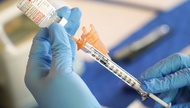If you haven’t contracted COVID-19 since the holidays, you probably know someone who has, or maybe lots of people who have. The coronavirus’ latest variant, omicron, has been spreading like wildfire, bringing the pandemic that dominated our lives in 2020 and 2021 back into sharp focus as 2022 begins.
At press time, the total number of COVID cases recorded in the United States had reached 58 million, according to John Hopkins University data, and The New York Times’ “hot spots” map showed Nevada turning dangerously purple, along with almost every other state in the country. The Times’ data also had Clark County’s reported cases up 228% over the previous 14 days.
And according to Dr. Amy Stone, an assistant professor of microbiology and immunology at Touro University Nevada, data from the Centers for Disease Control and Prevention (CDC) indicates that 82.4% of Nevada’s recent recorded cases were of the omicron version as of January 7, compared with 17.6% for delta, previously the dominant COVID strain.
What’s the difference? For one, omicron has been shown to be far more contagious, about 35% more transmissible than the delta variant, at latest report. Stone says the Southern Nevada Health District is seeing a test positivity rate of 20%, meaning one in five people who get tested for COVID actually have it.
On the bright side, omicron appears to be linked to a lower percentage of serious and fatal infections than delta before it.
“What we think is happening is that instead of getting down deep into the lungs, like delta, or the original COVID did, [omicron] stays up higher—more in your higher chest area,” Stone says. “That makes it easier to breathe in and out, because it’s right there at the top rather than being very deep into the lungs.”
That doesn’t mean omicron can’t be dangerous, however. “We are still going to see deaths,” says Dr. Brian Labus, an assistant professor at UNLV’s School of Public Health and an expert in communicable disease. “We’re seeing that now around the country—hospitalization numbers are going up everywhere. Deaths trail that by three or four weeks. … Just because it might be slightly better, doesn’t mean it’s something you want to get, and it doesn’t mean it’s something that’s going to be a mild infection if you’re not vaccinated.”
Aside from the immunocompromised, studies show that unvaccinated people are most vulnerable to omicron. Both Stone and Labus stressed that being fully vaccinated—including a booster shot—is the best way to protect yourself.
The CDC recently updated its recommendations for Moderna or Pfizer-BioNTech boosters, reducing the interval between the primary series of shots and the booster from six months to five. At press time, the booster interval for those who received the Johnson & Johnson single-dose vaccine remained the same, two months.
How else to minimize your risk of contracting omicron? Mostly by taking steps with which we’re quite familiar by now. Stone suggests both vaccinated and unvaccinated folks should continue to wear masks and maintain 3 to 6 feet between themselves and others—especially unmasked people. Front-line workers or those working with the public in any way should wash their hands once an hour or utilize an alcohol-based hand sanitizer frequently.
Labus echoes that advice, specifically suggesting either a KN95 mask or layers for those continuing to use surgical or cloth masks. And though omicron might not result in the same sorts of lockdown measures we’ve seen in the past, Labus says people should truly weigh potential gatherings before attending.
Folks should also stay home if they feel any sign of the virus, both experts emphasized. Omicron symptoms include a runny nose, a sore throat and nasal congestion, according to NPR.org. If a cough is present, it’s typically mild, and the loss of smell and taste aren’t as common with omicron as with previous variants, NPR reported. But, the report indicated, more serious symptoms—ranging from fever to chest pains and trouble breathing—can still show up.
If you have a suspected or confirmed case of COVID, isolate yourself from others for at least five full days (day zero is the first day of symptoms or positive test for those asymptomatic), as recommended by the CDC.
Sam Boyd Stadium recently opened as a large local testing site, but if you’re still running into trouble getting a PCR test, home tests are also effective, Labus says, and typically pick up the omicron variant, contrary to some reports.
“They just have to be used properly,” he says. “The timing of the test is important. If people are testing themselves at the first sign of illness, they’re going to test negative, because it’s too early for the test to detect it. The best chance of finding it is on day three after onset.”
Once it runs its course, might omicron mark the end of COVID, at last? Not likely, Labus says. Globally, the virus mutates, on average, two times per month, he explains, yet another reason why vaccines are so essential. At press time, the CDC was reporting that 74.3% of Americans had received one dose, 62.5% were fully vaccinated and 36.3% had also been boosted.
“Until we have [herd immunity], the virus is going to continue to mutate,” Stone says. “Every time it infects a person, it has a chance to mutate and change, and every change has that chance of making it better for the virus—more deadly, more transmissible.”
Click HERE to subscribe for free to the Weekly Fix, the digital edition of Las Vegas Weekly! Stay up to date with the latest on Las Vegas concerts, shows, restaurants, bars and more, sent directly to your inbox!





